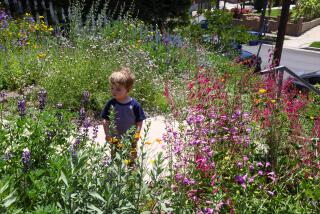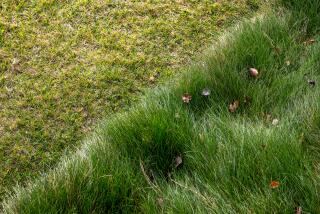Manure may not work
Regardless of El Niño storms or La Niña droughts, winter often brings one reliable change to Southern California gardens: a brown lawn.
Some newer, tall fescue grasses stay green year-round, but thousands of lawns in older neighborhoods stick with the old standbys -- Bermuda or St. Augustine grasses -- both of which go dormant in the winter.
That leaves homeowners with a choice: Let the lawn stay brown until spring, or sow winter rye topped with manure. It’s a fairly easy job that is frequently done, unasked, by mow-and-blow crews, according to landscape contractor and gardener Bob Edmiston.
“It drives people nuts,” he says. “They hate the manure smell.”
The other problem with manure? It may not work.
Before we explain why, you can thank the Romans of the 1st century for spreading the message of manure throughout the Roman Empire and to the Moorish lands beyond. Although their understanding of how manure worked chemically may have been hazy, their appreciation of a comprehensive waste policy was inspiring. They targeted and categorized everything: night soil, offal and droppings from cesspits, privies, stables, corrals, aviaries, coops, butchers, tanneries and barnyards. They collected hair from the barbers and hoof shavings from the blacksmith, mixing up a heady concoction of organic putrefaction. Their dung palette was indeed rich: human, donkey, horse, sheep, goat, cattle, pigs and domesticated and wild fowl.
For gardeners today the cheapest solution, steer manure, is one of the worst, nursery experts say. It’s high in salt because of feedlot diets, and when it’s composted, much of the nutritional value is leached into the ground.
“What you’re buying is a bag of dust,” says Alan Gill, a staff member at Sunset Nursery in Silver Lake. “The only thing retained are the uric acids and the salts, and it’s going to salinate your soil to the point where it can inhibit plant growth.”
Horse manure, although more nutritional (and obtained free from local stables), is not much better. It has a high straw content and often is full of weed seeds.
In either case, manure laid down on a lawn is not feeding the soil; it’s merely protecting the scattered seeds. A better alternative, some experts suggest, is spending a few dollars more and applying seed cover such as Kellogg Topper or a lightweight planter mix. TruGreen, the lawn and landscape company, sometimes uses a dehydrated chicken manure. It comes in granules, doesn’t smell and is applied as a fertilizer, not a ground cover.
The best choice, of course, is to replace or reduce the size of your lawn in favor of drought-tolerant landscaping. But for those who insist on protecting their turf, Edmiston suggests a simple solution: Let the lawn go dormant.
“Ecologically it’s much better,” he says. “You can cut back on watering and mowing, saving gasoline and not adding green waste to the environment. You’d think people wouldn’t mind a reminder that it’s winter. I always hear the complaint that our weather is so monotone, nothing ever happens. Well, something did happen. Your lawn turned brown.”
More to Read
Sign up for The Wild
We’ll help you find the best places to hike, bike and run, as well as the perfect silent spots for meditation and yoga.
You may occasionally receive promotional content from the Los Angeles Times.









